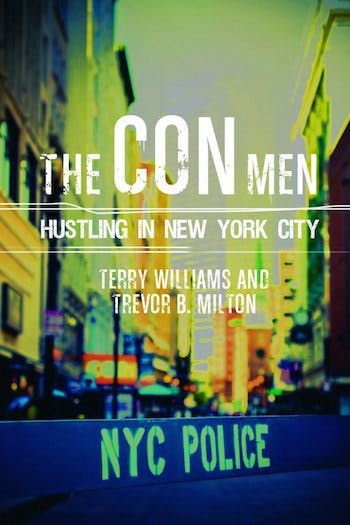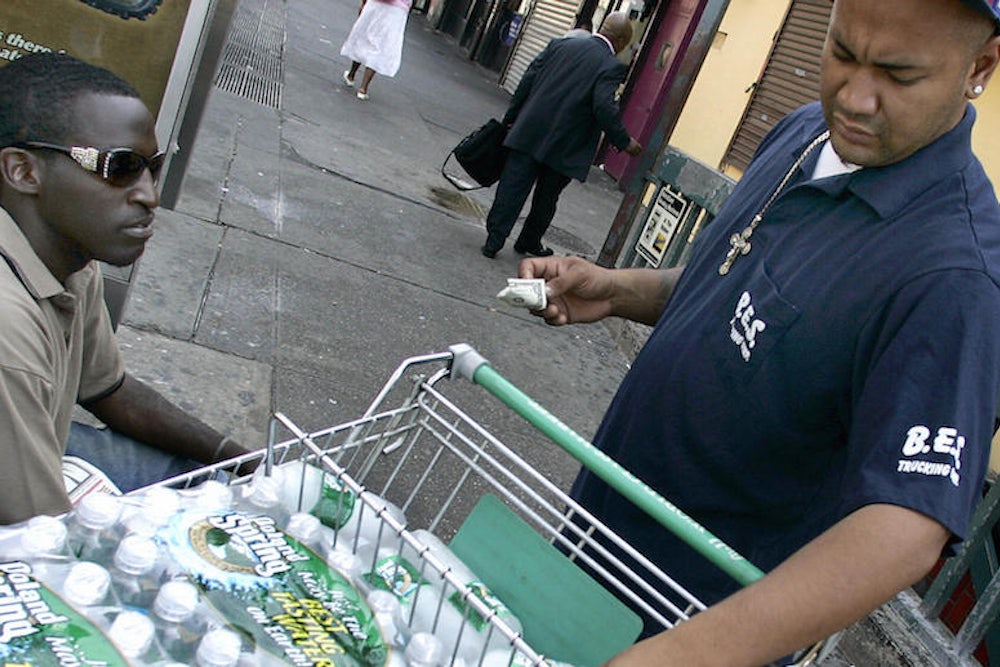Americans like con artists, or at least a certain kind, at least in theory. Considering they’re thieves this is quite an accomplishment, even though it’s highly conditional. But Americans have an unofficial code against knocking the hustle or hating the player. Culturally, we would rather someone creatively sucker some chumps than just ask for help. Con artists are, after all, small business owners.

In their new book The Con Men: Hustling in New York City, Terry Williams and Trevor B. Milton don’t bother to pretend not to be enchanted by their subjects. Con Men is a present-day investigation into some people who make a living against or around the law. It’s a PG-13 version that excludes crimes of violence, which are against the code, and only touches briefly on sex work. What’s left are hustles: Selling fake or stolen goods, dice and numbers games, quick confidence tricks, hawking water bottles and candy. Most of these play on the mark or customer’s combination of greed and their desire to be entertained. Unlike a mugging, they require some participation.
Williams and Milton are both professors in New York City and scholars of urban crime, and although they don’t have direct access to the underground, they do hint at some shady connections. Williams could have done a better job not implicating his brother-in-law’s brother in narcotics trafficking, and between the two of them the authors are able to bring the reader with them into places from Brooklyn to the Bronx that are supposed to be invisible to those not in the know. The book’s guide is a longtime scammer who goes by the name “Alibi,” and he takes Williams to his crew and shows him a few tricks of the trade.
Alibi’s team fits well with the cinematic picture we have of such an organization, including an unassuming older man and a hot, sassy young woman. Together they explain the mechanics of some of their cons. One of the games involves a confederate playing a foolish tourist waving around a bunch of money, just asking to be ripped off. They pick a mark and ask for help finding a hotel address, and along the way they pick up another confederate, a helpful “stranger” who hints to the mark that together they’ll be able to take the faux-tourist for their bankroll easy. “You can’t go in that hotel with all that money, let us hold it outside,” the confederate says. The mark is asked to put up some collateral along with the confederate, to prove he’s worth trusting. All the money and collateral go in a bag, one that the con switches when he shows the mark how best to hold it in his jacket. Everyone slips away, leaving the mark alone outside the hotel holding a bag of scrap paper.
It’s a lot of work for the payout, especially considering it requires a couple practiced people to pull it off and the most they can take a mark for is the cash in his pocket and his watch. Another team con is to call up someone in the phonebook, pretend to be the cops, and tell them a relative of theirs has been in an accident. The cop wants to get the relative out of a sticky situation, but someone has to pay the tow truck. The mark is asked to drop off money immediately at a city corner. It works, apparently, but Alibi says they ask for something like $40. For a split of $40 that sounds like a lot of work and risk. Desperation may be the mother of invention, but it can usually find a less complicated way to $40 than that.
The group cons are on the far artistic side of the hustles Williams and Milton describe. It’s art not just because it requires virtuosity and it’s fun to look at if you know what’s going on, but also because it’s not very utilitarian. For Alibi, the con’s life satisfies a very particular yet understandable set of conditions: He doesn’t want a 9 to 5 job, but he doesn’t have the temperament for violent crime or pimping. He’s quick but not formally educated. The reader gets the sense that this kind of con artistry is, for a crew leader like Alibi, a real vocation. It’s a way for him to use his talents and ingenuity to live in accordance with his day-to-day desires. How many of us can say we do that? It’s the sort of poverty that even capitalists find admirable.
Most of the hustles in The Con Men are not quite so complicated or artistic. As a New Yorker, one of the more enlightening was the operation of Canal Street discount electronics shops. Milton talks to a young man named Daniel who is heir to one of these stores, and he explains how they work. He concedes straight off that the stores are solely for tourists, and once the low sticker price—say, for a camera—gets them in the door, here’s how Daniel hits them: “The zoom lens is going to cost you another $150. The battery costs $150. I got this ten-gig memory that you absolutely need for $150. And I’ll throw in this carry case for $50. … So now I’m making $250 on top of retail, and if I really want to slam you, I’ll switch out the good SLR with a different Canon worth $150.” I always figured there was some sort of scam going on in those stores, but it’s fun to look inside and see how the gears move.
Williams and Milton don’t overlay these accounts with too much theory or analysis, mostly they let their respondents talk. At times this feels like a second-hand guided tour of the ghetto, a weak form that popular urban sociology often lapses into. Talking to a women named Maria, who takes and notarizes bets for the “numbers” street lottery, the authors get only a cursory glance into a complicated social structure that could no doubt fill a volume much larger than Con Men’s slim 250 or so pages. We learn the basics of how bets are made and calculated, how winning numbers are derived from horse races and legit lotteries, but not a lot of depth and no comparative breadth. Though Con Men is an engaging read for a layman and an outsider, I can imagine other academics and certainly hustlers themselves finding it lightweight.
There’s not a lot of academic virtuosity in Milton paying $20 to a young man—Lee—for a half hour interview about his gig selling water on a busy street, but this ends up being perhaps the most interesting section in the book. Lee engages in the most elemental enterprise imaginable: He buys by the case and sells by the bottle, a buck apiece. On a hot day he can move up to 40 an hour and clear $100 for a six-hour day. It’s illegal, but low-risk, and it is convenient for Lee, a dance teacher and college dropout with a taste for dice. “I’m not lazy,” he assures Milton, whose own job doesn’t involve hauling cases of water or standing in the street for hours, “but if I want to lay down for another hour, I’m going to lay down for another hour. I’ve actually never had a regular job before.” One hundred dollars a day isn’t career money, but it is what a young person might make at a solid part-time job.
From Lee’s story, Con Men draws its most interesting insight. The authors note that, like Lee, “quite a few youth look at all money making—either legitimate or illegitimate—as hustles that can be turned on and off at a moment’s notice.” When scholars and analysts talk about millennials as a hustler generation they don’t usually use young Black men selling water bottles on Atlantic Avenue as the archetype. And when talking about precarity or the gig economy or millennials who want to lay down for an hour when they want to lay down for an hour, we’re conditioned to think in terms of branded platforms: Uber, Postmates, AirBnB. These companies have put a shiny new label—as well as taxable legitimacy and a middleman fee—on age-old hustles. In Lee’s spare time—when he isn’t selling water bottles, teaching dance, or planning to go back to school—he records and edits YouTube skits, looking to hit it big, and maybe he will. We rarely connect the social media star and the 20-something selling water bottles. By sheer numbers, we should see Lee as the generational representative, not the lucky millionaire app developer. If we thought about it that way, maybe all the e-hustle platforms wouldn’t look so promising.
“Whether or not they are aware of the causes of the current job market,” the authors write, “many millennials have accepted this and as a result have adopted a ‘fly high and crash hard’ mentality toward income earning.” They call it a hustler generation, but Lee is no con man. He’s out creating demand for big-box water sellers or generating content for Google, all without costing any employers a dime in wages or benefits. And despite being defined by his constant hard work, Lee still feels the need to explain that he’s not lazy. He may not have a boss, but if there’s a con going on here then Lee, and the rest of the hustler generation, are the marks.
